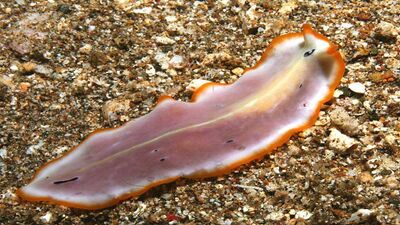Flatworms: Difference between revisions
Jump to navigation
Jump to search
No edit summary |
No edit summary |
||
| Line 33: | Line 33: | ||
|colspan="2" |Source: Integrated Taxonomic Information System | |colspan="2" |Source: Integrated Taxonomic Information System | ||
|} | |} | ||
Flatworms are the simplest of the worm groups. There are roughly 20,000 species. Flatworms are found globally and can be free-living or parasitic. One of the best-known flatworms is the tapeworm. | |||
=Habitat= | |||
=Diet= | |||
=Reproduction= | |||
=Anthropogenic Benefits= | |||
=Anthropogenic Drawbacks= | |||
{| class="wikitable" style="margin-left:4px" | {| class="wikitable" style="margin-left:4px" | ||
! Attribute !! [[Cnidarian]]s and [[Ctenophore]]s !! [[Platyhelminthes]] (flatworms) || More "advanced" [[bilateria]]ns }} | ! Attribute !! [[Cnidarian]]s and [[Ctenophore]]s !! [[Platyhelminthes]] (flatworms) || More "advanced" [[bilateria]]ns }} | ||
Revision as of 18:10, 22 April 2023

| |
| Kingdom: | Animalia |
|---|---|
| Subkingdom: | Eumetazoa |
| Clade: | ParaHoxozoa |
| Clade: | Bilateria |
| Clade: | Nephrozoa |
| Unranked: | Protostomia |
| Unranked: | Spiralia |
| Clade: | Rouphozoa |
| Phylum: | Platyhelminthes |
| Source: Integrated Taxonomic Information System | |
Flatworms are the simplest of the worm groups. There are roughly 20,000 species. Flatworms are found globally and can be free-living or parasitic. One of the best-known flatworms is the tapeworm.
Habitat
Diet
Reproduction
Anthropogenic Benefits
Anthropogenic Drawbacks
| Attribute | Cnidarians and Ctenophores | Platyhelminthes (flatworms) | More "advanced" bilaterians }} |
|---|---|---|---|
| Bilateral symmetry | No | Yes | |
| Number of main cell layers | Two, with jelly-like layer between them (mesoglea) | Three | |
| Distinct brain | No | Yes | |
| Specialized digestive system | No | Yes | |
| Specialized excretory system | No | Yes | |
| Body cavity containing internal organs | No | Yes | |
| Specialized circulatory and respiratory organs | No | Yes | |